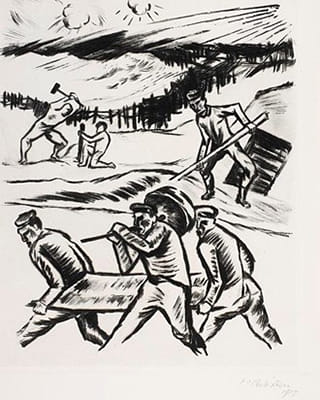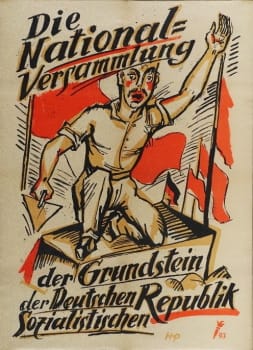Summary of Max Pechstein
Pechstein was a prolific painter and printmaker who first announced himself to the artworld through an audacious series of boldly-colored nudes and landscapes. Following an early association with the infamous Die Brücke group, Pechstein plotted his own career path, becoming a key player in promoting Expressionism within the international avant-garde. Inspired by the Fauvists, his work became increasingly influenced by non-Western art forms. However, Pechstein's "primitive" art met with the same fate as that of many of his peers when it was condemned as "degenerate" by the Nazi party. After the war, Pechstein's contribution to German art and culture was fully acknowledged when he was made Honorary Senator at the University of Fine Arts in Berlin.
Accomplishments
- As an invited member of Die Brücke, Pechstein was part of a radical shift that saw the group bridge the art of the past and the art of the present (and future). Pechstein's nudes and landscapes, with their preference for jagged angles and bold, flat color, represented a reaction against the conservative arts establishment and helped deliver German art into the modern era.
- Pechstein's "illiterate" non-naturalistic style (he was in fact trained to a high academic standard) was illustrative of the Expressionists' fixation on capturing something of the inner feelings and moods of the artist. The simple immediacy of his art also supported Pechstein's socialist principles - "art is not a pastime", he once said, but "a duty with respect to the people" - which remained a key element of his involvement with socialist art groups during the interwar years.
- Pechstein was a prolific printmaker who played an important role in reinventing one of the most important traditions in German art: the woodcut. Recalling the prints and drawings of the Northern Renaissance master, Albrecht Dürer, he was, with Erich Heckel, at the forefront of a technique that has become emblematic of German Expressionism. Pechstein made more than nine hundred lithographs and woodcuts, many printed and distributed in his own small hand-crafted editions; others for established Berlin publishers who commissioned him to work on portfolios and book illustrations.
- Pechstein was emboldened by the Fauvist styles of Henri Matisse and Paul Gauguin. Indeed, just as Gauguin had traveled to Tahiti, Pechstein traveled to Palau in the western Pacific, where he too painted local subjects including nudes, landscapes, and plant life. Pechstein's self-consciously "exotic" style saw him using thick contour lines, exuberant brush strokes and contrasting, acidic, colours. When the Nazis came to power, Pechstein's "primitive" paintings were duly placed in the infamous exhibition of Degenerate Art (Entartete Kunst) of 1937.
The Life of Max Pechstein

Reflecting on his involvement with Die Brücke, Pechstein stated: "We caused wild clamoring, not just in the Dresden press, but in the entire art scene. For the well-behaved philistine ... we were welcome objects for ridicule and derision. But that did not bother us".
Important Art by Max Pechstein

Akte im Freien (Under the Trees)
The lucid brushstrokes and vibrant, yet unnaturalistic, colors used by Pechstein in this scene create a sense of the joys of being "at one" with nature. The whirling sky and the foliage of the trees and grass, gives the impression of dynamism and movement. Meanwhile, four female nude figures vie for the viewers' attention in the fore and middle-ground as they frolic with abandon in their luscious natural surroundings. The use of "hot" colors such as reds, oranges, and yellows, add to the impression of a summer's day, even though the colors are defiantly non-naturistic.
Following his membership of Die Brücke group, Pechstein often joined his fellow artists, Erich Heckel and Ernst Ludwig Kirchner, at the Moritzburg lakes and forests on the outskirts of Dresden. This painting is typical of the men's desire to embrace nature and paint more traditional scenes, albeit it in a modern way (the name "Die Brücke" - "The Bridge" - referring to the joining of the past with the present). Pechstein's painting also displays the group's preoccupation with the female nude, again a traditional subject in art but reinterpreted here through fluid and bold black outlines, and warm, yet unusual, orange and red tones. In its stylistic approach, the painting is comparable to the work of the French Fauvists, who Pechstein greatly admired.
Oil on canvas - Detroit Institute of Arts, Detroit

Fraukopf (Woman's Head)
In this work, Pechstein has used quick and sweeping brushswork to create decisive marks on his canvas. His expressive technique conveys a sense of "casual urgency", as if the work had been completed spontaneously. The use of vivid colors create an unnatural portrait, in which the woman's eyes are framed in deep red (eyeliner?), mirrored by red strands in her yellow hair. Unlike his larger canvases of this period, the scale and simplicity of this portrait suggest it could be a study for a larger work, or an early experiment in capturing the essence of a subject in a short space of time.
Painted shortly after his arrival in Berlin (following his travels to Italy and France) Pechstein's use of gestural marks using non-naturalistic colors illustrate the German's search for expressions of inner moods and feelings over more precise literal portrayals. The simple immediacy of the representation of the woman also tallies with Pechstein's call for a modern art that could be appreciated and enjoyed by "the masses". His socialist philosophy was a key component in his worldview and can be traced from Pechstein's time in Die Brücke, right through to his involvement in the interwar socialist art groups, Neue Secession and the Novembergruppe, and in his post war academic career.
Oil on canvas - M. T. Abraham Center
Design for Arbeitsrat für Kunst flyer
Rendered in blunt monochrome, Pechstein has used dynamic lines to create a sense of movement and vitality in this woodcut. It reflects his political enthusiasm following the socialist revolution and the subsequent birth of the Weimar Republic. To the left of the frame, three craftspeople work together to forge a new path ahead against a backdrop of stars and dynamic lines. To the right, the large-scale letters exclaim to group's name - Arbeitsrat für Kunst - Workers Council for Art.
Pechstein produced this "flyer" to promote the work of the newly established Council. Its goal was to unite creative individuals from all spheres of the arts (including painters, sculptors, writers, and architects) to help realize the socialist revolution, and to deliver an art fit for the Republican workers. Pechstein's decision to use the woodcut method (revisiting his earlier work with Die Brücke) saw him turn to traditional methods for the most immediate way of creating, reproducing and disseminating art amongst the working classes. As the art historian Christian Weikop put it, Pechstein turned to the woodcut "because the honest physicality in the manual work of the land or seafaring peasant was aptly expressed in the physicality of the medium".
Ink on paper

Sommeschlacht VII - Soldaten Beim Schanzen (Soldiers Digging A Trench)
The use of jet black ink and heavy stark lines articulates the somber nature of this artwork. Six soldiers are seen toiling to dig a trench: three in the foreground carrying tools and a stretcher, one in the middle ground digging with a spade, and two in the background, hammering pegs into the ground. The soldiers' facial expressions tell us nothing of their individuality or personality; their matching uniforms adding to the effect of anonymity and group identity.
Pechstein's use of the etching technique emphasizes the stark contrasts of this work. In the etching process, lines are incised using acid into a metal plate to create areas to hold the ink for transferal onto paper. The subject matter of this work was one that Pechstein had firsthand experience of, having been drafted into the German Army during the First World War and sent to fight on the frontline. The psychological effects of warfare can be seen in a series of etchings similar to this one, in which the artist's primitive style directly communicates the grim and traumatic conditions he himself had experienced (and, indeed, had suffered from emotionally and psychologically).
Etching on paper - Imperial War Museum, London
Summer in Nidden
This painting depicts a bright summer's day in Nidden, a small fishing village on the Baltic coast of East Prussia (now Lithuania). On painting at Nidden, Pechstein stated, "I soaked up light and color in this nature unspoilt by humans ... My art, the work as a fisherman's deckhand and the joys connected with this were inseparable". Since his first visit in the summer of 1909, and throughout his time as a member of Die Brücke, Nidden was a place of inspiration for Pechstein. Indeed, Nidden became a favorite retreat of the artist throughout his lifetime.
In this idyllic pastoral setting, and the perfect retreat from the urban milieus of Dresden or Berlin, Pechstein illustrates three nudes with angular forms seeking shade from the sun and hanging up a bathing towel to dry. The artist's use of dynamic unnaturalistic color emphasize, and rejoice in, the rays of a sun that illuminates a landscape of the luscious greens and yellows. Painted after the First World War, this image conjures a sense of a simpler and more innocent time (and is in contrast to his harrowing monochromatic war etchings). Indeed, the image revives the expressive color and impasto brushwork that was similar in style to Gauguin and the Fauvist, and from whom, Pechstein took such inspiration.
Oil on canvas - Museo Nacional Thyssen-Bornemisza, Madrid
And Lead us Not into Temptation
In the post-war years, Pechstein became fully committed to the birth of a new Germany. He was a member of two groups: the Arbeitsrat für Kunst (the Workers Council for Art) and the Novembergruppe (November Group), having co-founded the latter with César Klein. The goal of both groups was to promote the role culture could play in enriching peoples' lives in the new Weimar Republic. However, Pechstein would start to test the principle that art could affect meaningful social reform and he began to look for other ways to make sense of his world.
Pechstein found his answer, not in blunt socialist politics, nor in radical new art practices, but rather in heavenly intervention and in a return to his earlier expressionistic woodcut technique. In 1922, the same year he accepted a professorship at the Prussian Academy of Arts in Berlin, Pechstein producing a remarkable series of 12 hand-colored woodcuts which he collectively titled, Das Vater Unser (The Lord's Prayer). The works carried with them much of the expressionistic angst of the Die Brücke works. Yet here Pechstein looked to Christianity as a way of conveying a positive moral message; one that might help unite the people of the new Republic.
As MoMA describes, "Promising forgiveness and deliverance from evil, the Lord's Prayer resonated powerfully in postwar German society, which was saddled with war guilt and reparations, beset by hunger, and racked by civil unrest and political violence. Pechstein illustrated a single verse of the Lord's Prayer on each of this portfolio's twelve sheets, following the German translation from Martin Luther's Small Catechism, which emphasizes the power of individual prayer. [His] woodcuts contrast God's grandeur and omnipotence with his humble followers' modest lives. The artist clothed the faithful in the simple garb of Baltic fishermen, familiar to him from his repeated stays in the village of Nidden. Their masklike faces and blocky, angular bodies combine the styles of medieval German woodcuts and forms sourced from the South Pacific, which Pechstein had visited before World War I, and from Africa".
Hand colored woodcut
Biography of Max Pechstein
Childhood
Hermann Max Pechstein was born into a working-class family in the industrial town of Zwickau in Saxony. His father, Franz Hermann Pechstein, worked as a foreman in the Kammgarnspinnerei Petrikowsy & Co textile mill in the nearby area of Schedewitz, whilst his mother, Lina Richter, raised Max and his seven siblings in a small flat in a tenement block near the town's train station. His family had a rich background in manual crafts, working in the textile industry but also as blacksmiths. Pechstein went to the local Citizens' School before working as an apprentice decorator between 1896 and 1900. At the age of nineteen, and having already been captivated by the paintings of Vincent van Gogh, he left Zwickau and enrolled at the Royal Art Academy in Dresden where he studied with the decorative artist and designer, Otto Gussman. Under Gussman's guidance, Pechstein learnt the art of stained glass, murals, and mosaics. It was during this time that he also began to experiment with the woodcut process, a technique he would use throughout his career.
Early Training and Work
Pechstein graduated from the Academy with the highest distinction, the Saxon State Prize, in 1906. However, his ceiling painting at the Dresden Arts and Crafts Exhibition of 1906, was rendered in such unnaturalistic colors that the Exhibition's organizers sprayed the painting with a grey paint mixture to soften its tones. The "doctored" work still attracted the attention of Erich Heckel, co-founder, with Ernst Ludwig Kirchner, Fritz Bleyl, and Karl Schmidt-Rottluff, of the newly formed Expressionist Die Brücke (The Bridge) group. Having been formally invited by Schmidt-Rottluff to join Die Brücke, Pechstein started to experiment with other art forms, including lithographs and etchings.
The art theorist Irit Rogoff has described Die Brücke as "a particularly German phenomenon [...] the search for relevant new visual forms which would convey both the social and the elemental aspects of modern man". Pechstein said on meeting Heckel in 1906 "We were delighted to discover a complete consonance in our urge for liberation, for an art that stormed forwards unconstrained by convention". Die Brücke's key values were utopian, and it sought a revolution in German art. Its methods, however, revived traditional German printmaking techniques, with a view that they could reach a wider audience through multiple reproductions and easy dissemination. Their inspiration borrowed from German masters of the past, such as Hans Holbein and Albrecht Dürer, and blended it with the non-Western cultures of Africa and the South Sea Islands which were newly on display at the Museum für Völkerkunde Dresden (Dresden Museum of Ethnology).

For Die Brücke, it was next generation German artists who would be instrumental in affecting their vision of change. The group's manifesto, carved in wood by Kirchner, declared: "With faith in the development of a new generation of creators and consumers we call together all youth. As youth, we carry the future and want to create for ourselves freedom of life and movement against the long-established older forces". Living in rented studios in working-class areas, they sought to dispense with class and conventional bourgeois morality and embraced the concept of uninhibited self-expression.
During his early career, Pechstein often participated in en plein air painting trips to the Moritzburg Lakes outside Dresden with fellow members of Die Brücke. At the lakes, he experimented with non-naturalistic color, wild textures, and basic lines in the style of Henri Matisse and Paul Gauguin. In the fall of 1907, after winning the prestigious Dresden Kunstakademie's Rome prize, Pechstein traveled to Italy, where he visited Florence, Ravenna, and Rome, participating in the first graphic exhibition of the German Association of Artists. In 1908, during a brief stay in Paris, he met the Fauvist painter Kees van Dongen and invited him to join Die Brücke (which he did, albeit briefly). In 1909, Pechstein moved to Berlin, securing commissions decorating private residences - including the Villa Peris, built by Mies van der Rohe - and exhibiting his lithographs and paintings with the Berliner Sezession (Berlin Secession) a group of 65 artists who took a stand against (or "seceded" from) the standards of the state sanctioned academic art.
Mature Period
By 1910, and leaving behind the rather conservative tastes of its leading galleries, Berlin was becoming a hub of new creativity in German art. The shift was exemplified by the Berlin Secession movement. But that year Pechstein's art was rejected by the Secession's founder, Max Liebermann. Undeterred, Pechstein, and fellow Expressionist, George Tappert, founded, with Pechstein as chair, the Neue Sezession (New Secession) which welcomed other artists rejected by Liebermann. The following year, Pechstein and Kirchner established the Moderner Unterricht in Malerei-institut (MUIM-Institut), a short-lived private painting school in Berlin. Also in 1911, Pechstein married Charlotte Kaprolat (with whom he had a son, Frank).
In 1912, Pechstein was formally "expelled" from Die Brücke for showing at Herwarth Walden's 1912 Der Sturm exhibition in Berlin (Kirchner had imposed a policy allowing Brücke members to exhibit only with other Brücke artists). Until then, Pechstein's involvement with Die Brücke had been fruitful for both parties. However, the founders of Die Brücke were in fact former architecture students, while Pechstein had received a solid formal arts training. As the Oxford Dictionary of Contemporary and Modern Art explains, "Among the German Expressionists [Pechstein] was the most French in spirit (he was particularly influenced by Matisse) and, probably because his work was essentially decorative rather than emotionally intense, he was the first member of the Brücke to achieve popular success and general recognition". Indeed, Pechstein's, Young Woman with a Red Parasol (1910), proved one of the most important works in promoting the work of Die Brücke group.
The Neue Secession showed artists associated with the Dresden Brücke, and avant garde artists from Munich who would later form Der Blaue Reiter group. As such, Pechstein can claim some credit for helping bring German Expressionism to the forefront of European modernism. However, Neue Secession was a short-lived enterprise and exhibited for the last time in 1914.
After his break with Die Brücke and the Neue Secession, Pechstein's art became more reduced and angular. In 1914 he travelled to the former German colony of Palau in the Pacific with his young family in order to capture "the way of island living". Sadly, the endeavor was cut short by the outbreak of the First World War. With most of the island artworks now lost, Pechstein was taken prisoner by the Japanese but was released after a year under an "oath of neutrality". He made his way back to Germany, working as a coal trimmer on a steamer, via the USA and Holland.
In 1916 Pechstein was drafted into the German Army and was sent to fight in the trenches on the Western Front. He fought in the terrible battles of the Somme and Flanders which badly affected his mental wellbeing (leading to a nervous breakdown). The horrors he had witnessed led to a series of paintings and lithographs, including the harrowing, Self Portrait with Death (1920).

After the War, Pechstein and the Expressionist artists César Klein formed the Socialist Republic group. Known as the Novembergruppe (November Group), named after the month of the Weimar Revolution of 1918, the group - which would count amongst its associates (as formal membership was not mandatory) the likes of Käthe Kollwitz, Otto Dix, Walter Gropius, Mies van der Rohe, Hans Richter, El Lissitzky, George Grosz, Otto Nagel and Bertolt Brecht - was linked through a shared commitment to encourage a socialist agenda in the arts and crafts, architecture, and city planning. The group, which merged with the Arbeitsrat für Kunst (the Workers Council for Art) in 1919, focused its efforts on the (re)organization of art schools and campaigned for the value of culture in the everyday lives of the working people of the newly formed Weimar Republic. (Berlin's, Berlinische Galerie of Modern Art, states that "Between 1919 and 1932 [it was outlawed by the Nazis in 1933] the Novembergruppe mounted almost 40 exhibitions, published books and organized concerts, readings, parties and fancy-dress balls. In this way the association publicized modernist art on many different levels".)
Late Period
The year 1922 represented something of a turning point in Pechstein's life. He accepted a professorship at the Prussian Academy of the Arts in Berlin and separated from his wife Charlotte. Pechstein also turned from socialism to Christianity, producing a striking series of 12 hand-colored woodcuts called, Das Vater Unser (The Lord's Prayer). In 1923 he married Marta Möller (the couple welcomed a son, Max, in 1926). Pechstein's professional career within the new academia of the Weimar Republic continued to strengthen and in 1928, he was awarded the Prussian State Prize and elected to the exhibition commission of the Academy of Arts.

Pechstein's successes during the 1920s were brought to a shuddering halt, however, with the rise of the Nazi Party. Scrutiny around modern art and left-wing artists continued to intensify, until, in 1933, Pechstein was removed from his teaching position and banned from painting or exhibiting. The following year, his work was prohibited from being sold in Germany altogether, and in 1937, 326 of his paintings were removed from German museums. 1937 also marked the Entartete Kunst Ausstellung (Degenerate Art Exhibition), organized by the painter and politician Adolf Ziegler on behalf of the Nazi Party in Munich - it later toured German cities. The exhibition displayed artworks removed from German museums and deemed, in the words of Adolf Hitler, "[to] insult German feeling, or destroy or confuse natural form or simply reveal an absence of adequate manual and artistic skill". 16 of Pechstein's artworks were displayed alongside those of his past contemporaries Heckel, Kirchner, Schmidt-Rottluff, Nolde, and Mueller, as well as other key artists of the modern movement, including Marc Chagall, Max Ernst, Wassily Kandinsky, Oskar Schlemmer, and Pablo Picasso.

In light of the Degenerate Art exhibition, Pechstein and his family moved to rural Pomerania where they stayed until the end of the Second World War. Many of his works, including those stored in his apartment and studio in Berlin, were destroyed by fire during this time. In the last decade of his life, Pechstein enjoyed a return to art teaching; being appointed to positions at the University of Fine Arts in Berlin, including the accolade of Honorary Senator in 1951. Pechstein died at his West Berlin home in 1955.
The Legacy of Max Pechstein
Pechstein was a prolific artist whose paintings were complemented by lithographs, woodcuts and linocuts, and intaglio prints. His life was nothing short of eventful and he lived through some of the most dramatic events of the twentieth century German history - two World Wars, the establishment of the Weimar Republic, National Socialism, and the division of East and West Germany - which were all reflected, one way or other, in his art and his teaching. But his greatest legacy undoubtedly relates to his central role withing the rise of German Expressionism as the nation's defining modern art movement. Indeed, American scholar Donald E. Gordon points out that German Expressionism was "a movement essential to an understanding of modern art", period.
Because of the persecution of Expressionist artists by the Nazis, Pechstein's art has also become a discussion point in the larger project of Vergangenheitsbewältigung (working through the past) and the social and cultural rehabilitation of Germany following the disaster of the Second World War. Pechstein of course had a defining role in Die Brücke group, but also in the wider world of art and politics most evidently as the driving force in the formation of The Neue Secession and the Novembergruppe. His posthumously published memoirs, Max Pechstein: Erinnerungen (1960), are now considered an important primary source for the history of Die Brücke and his place in the success of German modernism.
Influences and Connections

-
![Erich Heckel]() Erich Heckel
Erich Heckel -
![Ernst Ludwig Kirchner]() Ernst Ludwig Kirchner
Ernst Ludwig Kirchner ![Fritz Bleyl]() Fritz Bleyl
Fritz Bleyl- Otto Gussman
- Wilhelm Kreis
-
![Emil Nolde]() Emil Nolde
Emil Nolde -
![Karl Schmidt-Rottluff]() Karl Schmidt-Rottluff
Karl Schmidt-Rottluff ![Otto Mueller]() Otto Mueller
Otto Mueller![Herwarth Walden]() Herwarth Walden
Herwarth Walden- César Klein
-
![Die Brücke]() Die Brücke
Die Brücke -
![Expressionism]() Expressionism
Expressionism - New Secession
- Novembergruppe
Useful Resources on Max Pechstein
- Max Pechstein: The Rise and Fall of ExpressionismOur PickBy Bernhard Fulda and Aya Soika
- New Perspectives on Brücke Expressionism: Bridging HistoryBy Christian Weikop
- Expressionism: A Revolution in German ArtBy Dietmar Elger
- 1920s BerlinBy Rainer Metzger
- German Expressionism: Art and SocietyBy Stephanie Barron and Wolf-Dieter Dube
- The Cambridge Companion to Modern German CultureBy Eva Kolinsky and Wilfried van der Will
 Ask The Art Story AI
Ask The Art Story AI





















